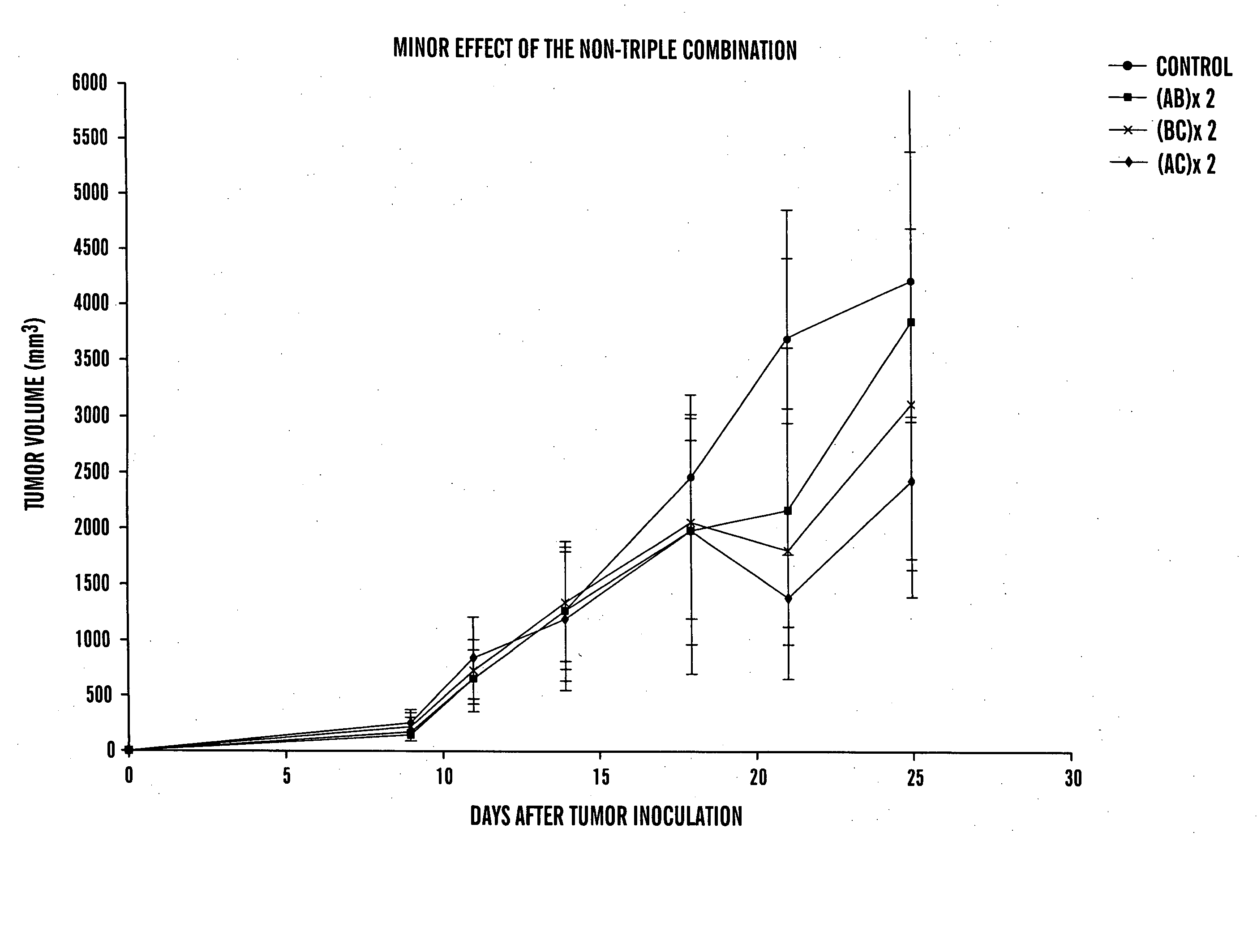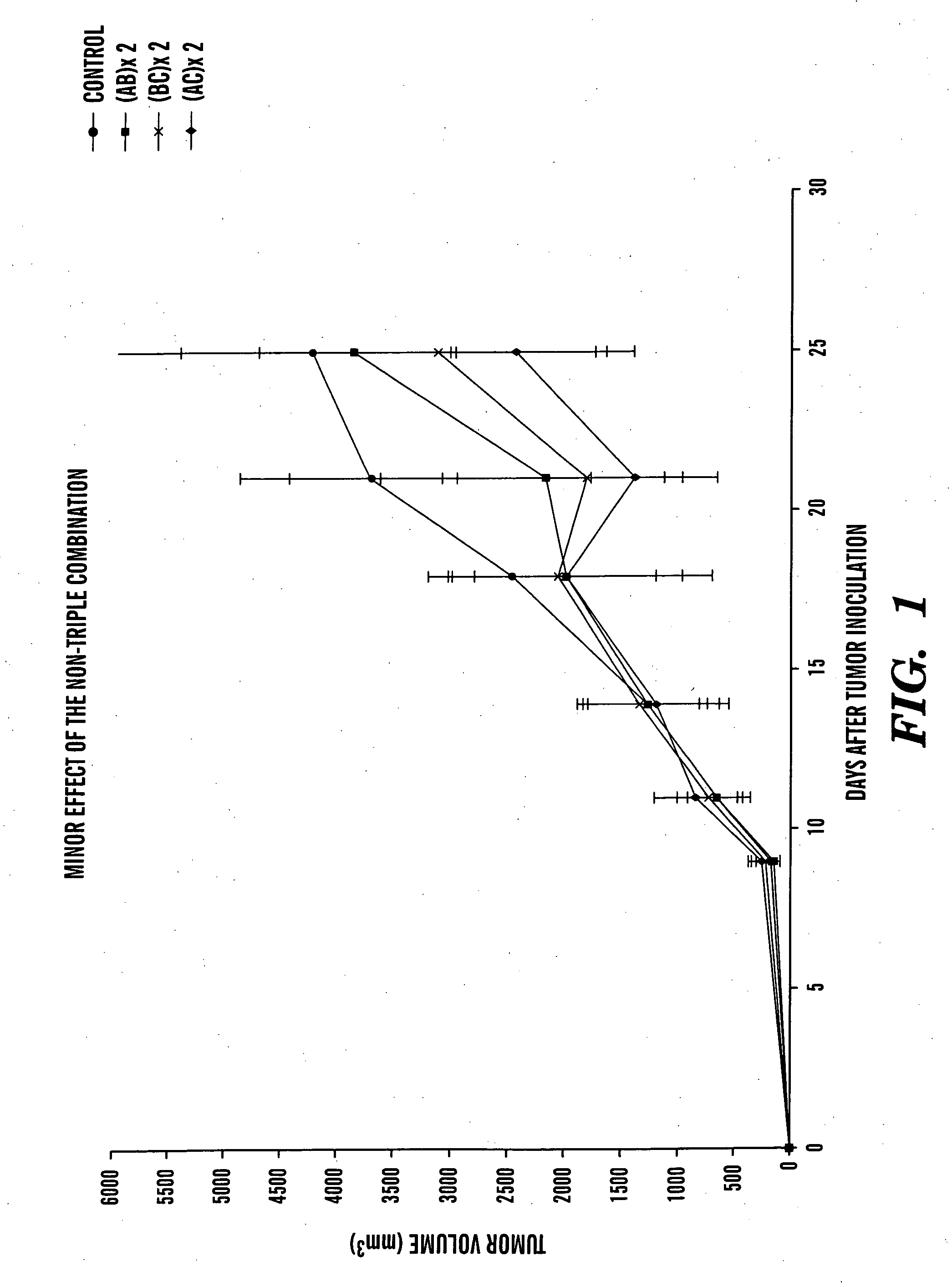Anti-cancer combination and use thereof
- Summary
- Abstract
- Description
- Claims
- Application Information
AI Technical Summary
Benefits of technology
Problems solved by technology
Method used
Image
Examples
example 1
Experiment 1
In Vivo Testing
[0127] Breast cancer is a highly lethal disease. To test the efficacy of rofecoxib, benzyl benzoate, cyclophosphamide, and pamidronate alone and in combination, a mouse breast cancer cell line, EMT6, that was originally isolated from a spontaneous tumor in a BALB / c mouse was used (Twentyman P R and Watson J V, Br. J. Cancer 35: 120 (1977)). This line was further selected for a drug resistant variant, EMT6 / CTX, that was used in this study (Teicher B A et al. Cancer Chemother. Pharmacol. 37: 601 (1996)). An EMT6 / CTX cell suspension was freshly prepared in DMEM medium+10% FCS, following trypsinization of cell grown in tissue culture. Anesthesia is performed by injecting 0.08 ml per mouse of Ketamine 30 mg / ml+0.07% Chanazine in PBS.
[0128] Subcutaneous inoculation of 3×105 cells at the shaved back of anesthetized C57BLXBALB / c F1 7-8 weeks old male mice results in palpable tumors within 4 days, and animals succumb to the tumor with around 4 weeks. Thus, thi...
experiment 2
[0138] The tumor model, drug formulation and tumor volume measurements were identical to Experiment 1. Again, 6 mice were used for each group. This experiment tested the effect of the drug combination of A+B+C.
[0139] Treatment per mouse twice a week: [0140] Group 1. Control vehicle; [0141] Group 2. ABC
[0142] The treatment started 5 days after cell inoculation. Treatment comprised an intraperitoneal injection of 0.1 ml per 20 gr body weight of the formulation. Mice were treated twice a week for a period of 3 weeks.
[0143] The results of this experiment are set forth in FIG. 2. As can be seen, the combination ABC dramatically reduced tumor growth. Mice exhibited less than 10% weight loss and no toxicity was observed.
experiment 3
[0144] The tumor model, drug formulation and tumor volume measurements were identical to Experiment 1. Seven mice were used for each group. This experiment tested the effect of cyclophosphamide by itself and with the drug combination of ABC. [0145] Group 1. Control vehicle [0146] Group 2. Cyclophosphamide 50 mg / kg (CTX 50) [0147] Group 3. ABC [0148] Group 4. ABC+CTX50
[0149] The treatment started 3 days after cell inoculation. Treatment comprised an intraperitoneal injection of 0.1 ml per 20 gr body weight of the formulation. Mice were treated twice a week for a period of 4 weeks.
[0150] The results are presented in FIG. 3 and demonstrated the superiority of the X4 combination protocol. While CTX 50 and ABC each by itself has a moderate effect on tumor growth, the X4 combination of ABC+CTX 50 yielded a synergistic effect.
PUM
| Property | Measurement | Unit |
|---|---|---|
| Time | aaaaa | aaaaa |
| Time | aaaaa | aaaaa |
| Time | aaaaa | aaaaa |
Abstract
Description
Claims
Application Information
 Login to View More
Login to View More - R&D
- Intellectual Property
- Life Sciences
- Materials
- Tech Scout
- Unparalleled Data Quality
- Higher Quality Content
- 60% Fewer Hallucinations
Browse by: Latest US Patents, China's latest patents, Technical Efficacy Thesaurus, Application Domain, Technology Topic, Popular Technical Reports.
© 2025 PatSnap. All rights reserved.Legal|Privacy policy|Modern Slavery Act Transparency Statement|Sitemap|About US| Contact US: help@patsnap.com



